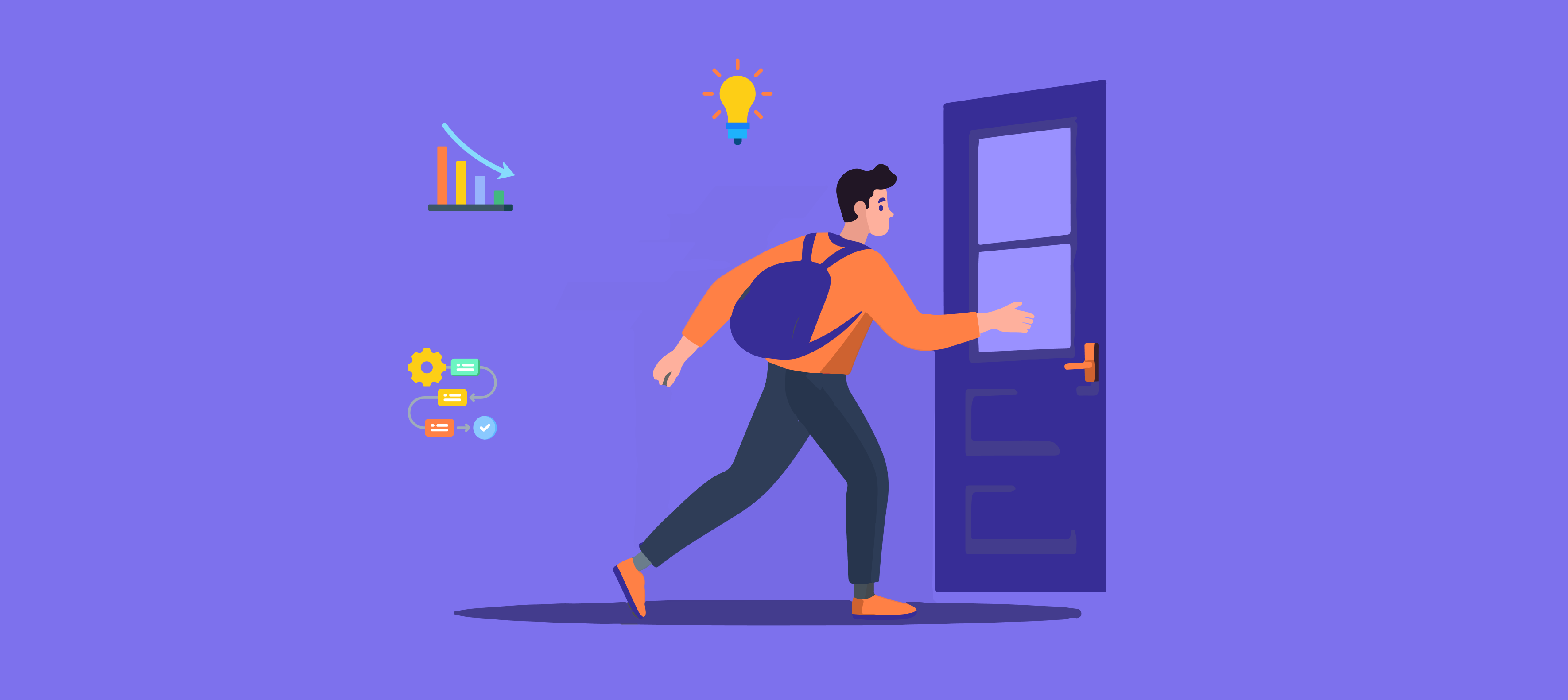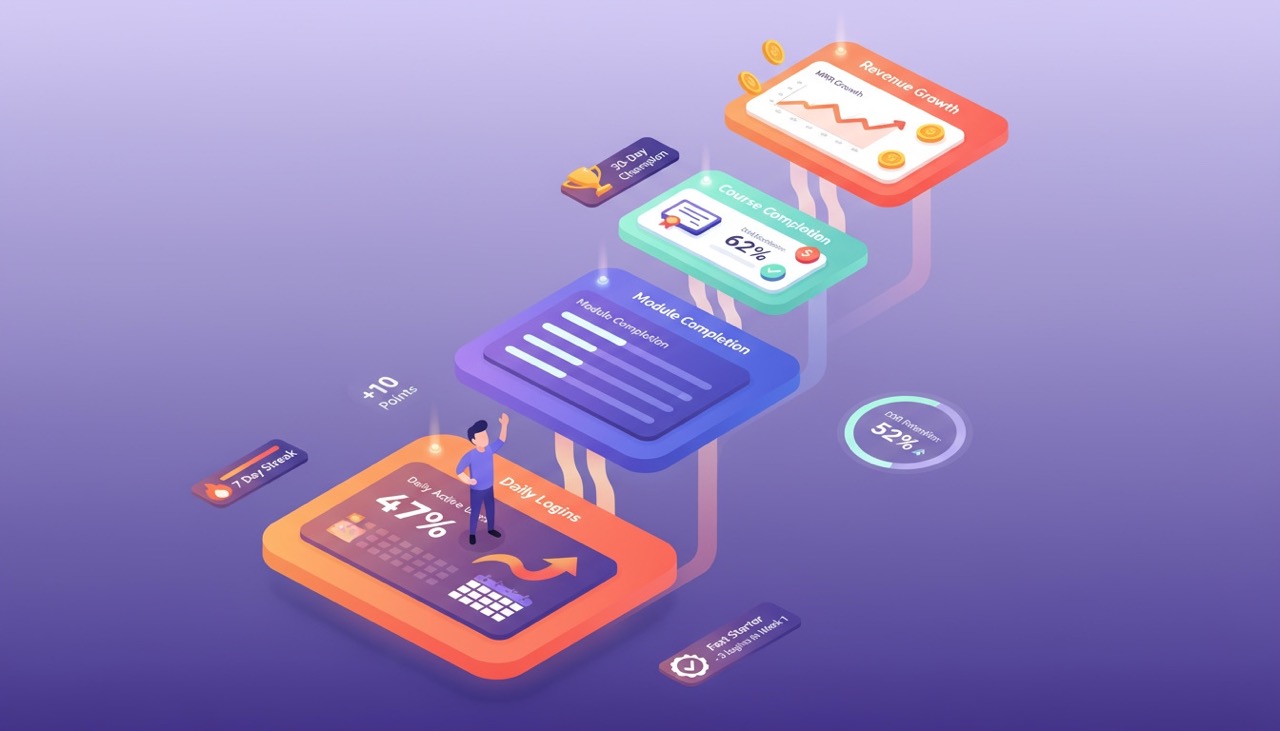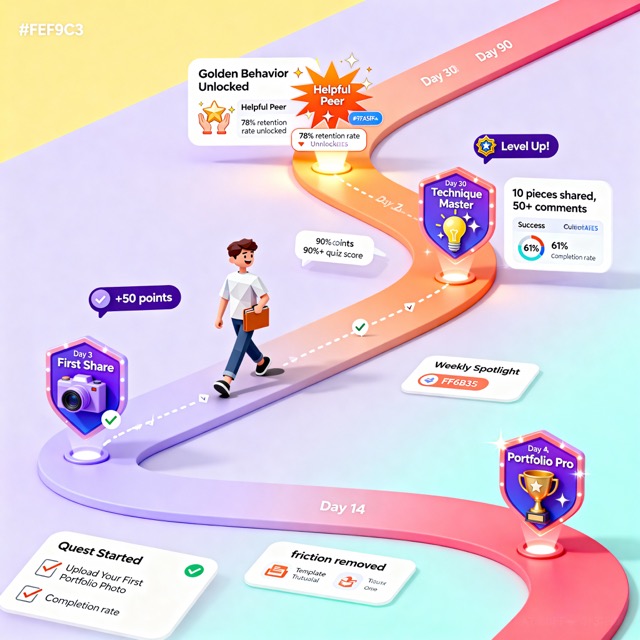







Why Your Gamification Isn't Working (And the 3 Questions That Fix It)

Sarah spent an entire weekend setting up gamification for her photography membership site.
She installed GamiPress, grabbed a few premium add-ons, and went to town. Fifteen badges. Three different point types (XP, Credits, and Karma... because why not?). A shiny leaderboard showcasing the top performers. She even created a "First Login" badge with a custom camera icon.
The first week? Electric. Forty percent of her members earned that First Login badge. The leaderboard had activity. Her analytics showed people clicking around, checking their points balance, viewing their profile achievements.
Week four? Only three people were still checking the leaderboard. The novelty had worn off faster than the excitement of a new lens.
Week eight? Course completion rates were still stuck at 32%. Nothing had changed. Actually, something had changed... a few of her most engaged members, the ones who used to help newcomers in the forums unprompted, had gone quiet.
The problem wasn't the $97 she spent on premium plugins. It was the opportunity cost of members who could have progressed, could have completed courses, could have stayed longer... but didn't. Because her gamification system was rewarding everything, which meant it was rewarding nothing that actually mattered.
Look, I'm going to be honest here. I've seen this pattern dozens of times when auditing membership sites. The initial spike, the rapid decline, the return to baseline (or worse). And every time, the root cause is the same: we're answering the wrong questions.
The difference between gamification that works and gamification that flops comes down to our EPIC framework: is it Engaging (driving real behavior change), Personalized (matching individual goals), Intuitive (clear next steps), and Community-driven (fostering connection, not hierarchy)?
We're asking "What mechanics can I add?" instead of "What behaviors actually predict success?"
Let me show you what to ask instead.
The Gamification Graveyard: Three Mistakes That Kill Engagement
Before we fix this, you need to understand why most membership site gamification fails. There are three predictable patterns I see constantly, and you're probably guilty of at least one.
Mistake #1: Rewarding Everything (Which Means Rewarding Nothing)
Points for logging in. Points for completing your profile. Points for uploading an avatar. Points for clicking a course. Points for breathing near your WordPress dashboard.
Here's the psychological trap nobody talks about... when you add extrinsic rewards (points, badges) to activities that members were already doing for their own reasons, you actually kill their internal motivation. It's called the Overjustification Effect, and it's destroying your most valuable members.
Think about it. Your super-users, the ones showing up in forums helping newbies because they genuinely enjoy it? When you start paying them in points for every helpful comment, their brain reframes the activity. Instead of "I help because I'm generous and knowledgeable," they start thinking "I help because I get points."
Then the points lose their novelty. And guess what? Their original intrinsic motivation doesn't come back. You've inadvertently demotivated the exact members who needed no motivation in the first place.
The data backs this up. Research shows that gamified learning environments can boost retention rates by 42% and completion rates by up to 39%... but only when implemented correctly. When done wrong, when you're just sprinkling points on everything, you often see net negative results, especially among your most engaged members.
Mistake #2: Badges Without Meaning
I call this "pointsification"... the practice of adding game scoring elements without connecting them to any real purpose or progress.
Compare these two badges:
- "Bronze Member" (logged in 10 times)
- "First Student Helped" (gave feedback that another member marked as helpful)
Which one tells a meaningful story? Which one makes someone feel competent and valued in the community?
The Bronze Member badge celebrates... what, exactly? The ability to remember a password? It's a vanity metric masquerading as achievement. The First Student Helped badge? That's connected to real value. It says "You're the kind of person others can count on. You're becoming an expert here."
This violates the Personalized principle of our EPIC framework. Generic badges don't recognize individual growth or align with personal goals. They're just noise.
Google News tried this. They added badges for reading articles on specific topics. Users found it intrusive and pointless. Many quit the service entirely. Because there was no social value, no personal meaning... just a digital sticker that meant nothing to anyone.
Mistake #3: Leaderboards That Demotivate the Majority
Here's the uncomfortable truth about leaderboards: they create a winner-take-all environment where the vast majority of users are perpetual losers.
I've seen this destroy communities. A global leaderboard gets installed, experts and highly active users naturally dominate the top spots (reinforcing their engagement), but everyone else sees their rank (147th, 423rd, 891st) and makes a rational decision: why compete in a game I can't win?
This is especially brutal for beginners. They're already vulnerable, already figuring things out, already battling imposter syndrome. Then they see a leaderboard that broadcasts "You're at the bottom, and these people are so far ahead you'll never catch up." That's not motivating. That's anxiety-inducing.
And it completely undermines the Community-driven principle. Instead of fostering connection and shared progress, you've created a rigid social hierarchy that punishes the vulnerability required for learning.
The leaderboard was supposed to motivate everyone. Instead, it alienated the members who needed the most encouragement.
Stop Adding Mechanics. Start Asking Better Questions.
The shift from broken gamification to a system that actually increases course completion rates and membership retention tactics starts with three strategic questions. Not "what should I add?" but "what actually matters?"
Question 1: What Behavior Actually Predicts Retention?
This is where most sites go wrong right out of the gate. They reward activities (logging in, profile completion) instead of the behaviors that actually indicate a member will stick around.
Sarah, our photography site owner, made this shift when she stopped guessing and started analyzing data.
She exported her member list and looked at the last 20 people who had stayed for 6+ months. Then she compared their first 30 days to the members who churned. The pattern was clear: members who shared their first portfolio piece within 14 days had a 78% retention rate. Members who didn't? Only 31%.
That was her "golden behavior." Not logging in. Not completing a profile. Sharing their work and making themselves vulnerable in the community.
So she stopped rewarding logins and started building her entire GamiPress strategy around that one behavior.
This is what makes gamification Engaging in our EPIC framework. It's tied to real progress toward a real goal, not arbitrary tasks that feel like busywork.
Here's how to find your golden behavior:
- Export your member data and segment by retention (6+ months vs. churned)
- Look for patterns in their first 30 days
- Interview your best members and ask: "What did you do early on that made you feel like this was the right place?"
- Pay attention to the scary, vulnerable actions (first post, first question, first share). Those are often your golden behaviors.
Question 2: What's the Next Action That Moves Them Toward Their Goal?
Once you know the behavior that predicts success, you need to make that behavior as effortless as possible.
BJ Fogg's behavioral model breaks this down simply: Behavior = Motivation × Ability × Prompt. Most sites max out motivation (EARN POINTS! GET BADGES!) while ignoring ability (is this easy to do?) and prompt (are we reminding them at the right time?).
Sarah redesigned her entire system around this. Instead of "Earn 50 points for daily login," she created a "First Portfolio Share Quest" with crystal-clear steps:
Step 1: Upload one photo (5-minute tutorial embedded right there, reducing friction and increasing ability)
Step 2: Write a brief description using a fill-in-the-blank template (again, making it easier)
Step 3: Tag one peer for feedback (building community connection from day one)
Then she added the prompt: an email on Day 3 if they hadn't started, plus an in-app checklist pinned to their dashboard showing exactly where they were in the process.
This is Intuitive design. The path forward is obvious. The friction is removed at every step. Members know exactly what to do next without hunting around.
The difference between this and "pointsification"? Sarah's quest moved members toward their actual goal (becoming a better photographer, getting feedback on their work). The points and badge were just the visible confirmation of real progress.
Question 3: What Milestone Deserves Celebration?
Not everything deserves a badge. In fact, most things don't.
You need to distinguish between participation badges (showing up) and achievement badges (demonstrating mastery or meaningful contribution). Both have a place, but if your system is 90% participation badges, you're celebrating activity instead of progress.
Sarah asked herself a brutal filter question for every badge: "Does this represent genuine progress toward the member's goal, or just activity?"
She deleted 11 badges and kept four meaningful ones:
- "First Share" (participation badge) - Builds initial momentum and confidence
- "Helpful Peer" (achievement badge) - Awarded when feedback you gave earned 5+ likes from others. This celebrates being valuable to the community.
- "Technique Master" (achievement badge) - Completed the advanced lighting course with 90%+ quiz scores. This validates real skill development.
- "Portfolio Pro" (achievement badge) - Shared 10 pieces and received 50+ total comments. This recognizes consistent engagement and growth.
Each badge triggered a Memberium automation: a personal video message from Sarah and unlocked next-level content. The badge wasn't the reward. The recognition and progression were.
This creates the Personalized recognition our EPIC framework demands. Each badge tied to individual growth paths, not generic checkboxes.
Real Results: How One Photography Membership 3X'd Course Completion
Let me show you Sarah's complete transformation, because the before-and-after tells the whole story.
Before: The Gamification Graveyard
Sarah's original setup looked like this:
- 15 badges including classics like "Logged In 3 Days in a Row," "Profile 100% Complete," and "Clicked 10 Posts"
- Generic points awarded for... basically everything
- A global leaderboard showing the top 20 (spoiler: the same four people were always there)
- Course completion stuck at 32%
- 90-day retention at 48%
- Member feedback: "I feel like I'm being tracked instead of helped"
The system was measuring activity, not progress. And members felt it.
After: Strategic Gamification
After running her audit and rebuilding around the three questions, here's what changed:
The New System:
- Four meaningful badges tied directly to behaviors that predicted retention
- Points only awarded for actions that moved members toward their goals (first share, giving quality feedback, course milestones)
- No global leaderboard. Instead, a "This Week's Helpful Members" spotlight featuring the top 5 people who gave valuable feedback. It reset weekly so everyone had a chance.
- Added a peer-to-peer "kudos" system where members could thank each other, creating social recognition that didn't require points
The Implementation Details:In GamiPress, she configured it like this: LearnDash Course Complete + Quiz Score 90%+ = "Technique Master" achievement → triggers Memberium tag → sends personalized congratulations video + unlocks bonus content.
For the "Helpful Peer" badge: BuddyBoss reply marked as "best answer" OR received 5+ likes = achievement earned + 50 Karma points + public recognition in weekly spotlight.
The Results (90 Days After Launch)
The numbers tell the story:
- Course completion: 32% → 61% (nearly doubled)
- 90-day retention: 48% → 73% (this is the metric that actually matters for membership sites)
- First portfolio shares: 22% → 67% of new members (the golden behavior, finally happening)
- Unexpected win: Forum activity up 40% because helping others now earned meaningful recognition
But here's my favorite data point... it's not a number. It's what one member said in the community: "I finally understand what I'm working toward. It's not about collecting points. It's about becoming a better photographer, and the badges just show me I'm on the right path."
That's when you know gamification is working. When it becomes invisible. When members aren't chasing points, they're chasing growth, and your system is just making that journey clearer.
Your Gamification Audit Checklist
You might be looking at your current setup thinking, "I've already built this thing. Do I really have to start over?"
Not necessarily. But you do need to audit it ruthlessly. Here's how to fix your membership site gamification system, even if you've already launched it.
Step 1: The Brutal Inventory (30 minutes)
Export every single point type, badge, and achievement from your GamiPress setup. Put them in a spreadsheet.
For each one, ask: "Does this celebrate a behavior that predicts retention or moves members toward their goal?"
If the answer is no, mark it for deletion.
Here's the hard truth: you'll probably delete 60-80% of what you've built. That's not failure. That's clarity. You're removing the noise so the signal can actually matter.
Step 2: Find Your Golden Behavior (1-2 hours)
You have three methods here, depending on your data:
Method 1 (if you have analytics): Compare your successful members (stayed 6+ months) vs. churned members. What did the successful ones do in their first 30 days that others didn't?
Method 2 (if you don't have clean data): Interview your five best, longest-tenured members. Ask them: "What did you do early on that made you feel like you belonged here?"
Method 3 (the hypothesis approach): What's the scariest, most vulnerable action a new member can take? First forum post? First shared project? First question asked? That's often your golden behavior. It's the moment where they cross from observer to participant.
Step 3: Rebuild Around the Journey (2-4 hours)
Map out 3-5 key milestones in a member's first 90 days. These become your achievement structure:
- Mile 1: First valuable action (share work, complete first lesson, post introduction)
- Mile 2: First community contribution (helpful reply, peer feedback given)
- Mile 3: First mastery demonstration (quiz passed with high score, project completed)
- Mile 4: First leadership action (mentoring newcomer, answering someone's question)
Create one meaningful badge per milestone. Use GamiPress sequential achievements to guide members through the path.
Step 4: Replace Leaderboards with Recognition (30 minutes)
If you have a global leaderboard, hide it. Or delete it entirely.
Create instead:
- Weekly or monthly "spotlights" that rotate (different category each week)
- Effort-based rankings like "Most Improved This Month"
- Friend-group only leaderboards (if you must have competition, keep it among peers, not the entire community)
Add social recognition that doesn't require points: community manager shoutouts, peer kudos, member-of-the-month features. This builds connection, not hierarchy.
Step 5: Remove Friction, Add Prompts (1 hour)
For your golden behavior specifically, list every single obstacle that makes it hard to complete. Every click, every decision, every moment of "wait, what do I do here?"
Then systematically reduce each obstacle:
- Provide templates for written content
- Add examples of what "good" looks like
- Embed short tutorials right where the action happens
- Pre-populate forms with helpful starter text
Finally, set up prompts using GamiPress progress maps: dashboard checklists, emails for incomplete actions, in-app nudges at the right time.
You can do all of this in a weekend. I've seen it work dozens of times.
The Shift From Points to Progress
Here's what most people get wrong about gamification: they think it's about making their site fun. It's not.
It's about making meaningful progress visible.
When done right, gamification becomes nearly invisible. Members aren't obsessing over their point balance. They're not farming easy lessons to climb a leaderboard. They're not collecting badges for the sake of collecting badges.
They're pursuing their actual goal (learning a skill, building a business, becoming part of a community), and your gamification system is just the infrastructure that makes their progress clear, their next steps obvious, and their achievements recognized.
The real metric isn't "how many badges were earned." It's "how many members reached their goal because the path was clearer?"
That's the shift. From points to progress. From mechanics to meaning. From "what can I add?" to "what actually matters?"
The question isn't "should I use gamification?" It's "am I using it to celebrate what actually matters?"
Your Next Steps
This week, here's what you should do:
Run the brutal inventory. Audit your current gamification setup against your retention data. Be ruthless. If a badge doesn't celebrate progress toward a member's goal, delete it.
Identify your golden behavior. Use one of the three methods above (data analysis, member interviews, or the vulnerability hypothesis) to find the one early action that predicts long-term success.
Rebuild one achievement path. Don't try to fix everything at once. Pick your most important member journey and create a clear, friction-free path through it with meaningful milestones.
Measure what matters. Track course completion rates, retention metrics (D7, D30, D90), and time-to-first-valuable-action. These tell the truth about whether your gamification is working.
Need help designing and building a gamification system that actually drives course completion and retention? This is exactly the kind of high-impact work we do at PB Digital. We've helped dozens of membership sites shift from pointsification to strategic systems that move business metrics. We love creating EPIC membership sites: Engaging, Personalized, Intuitive, and Community-driven.
Reach out and let's talk about your site. Sometimes you just need someone who's done this 50+ times to look at your setup and say, "Here's what's broken, here's how to fix it, and here's what to measure."
Recommended for you






